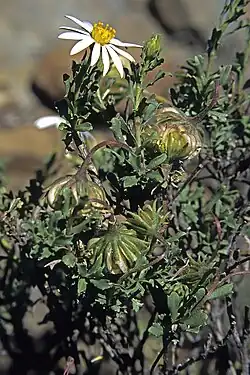Dimorphotheca cuneata
| Dimorphotheca cuneata | |
|---|---|

| |
| Scientific classification | |
| Kingdom: | Plantae |
| Clade: | Tracheophytes |
| Clade: | Angiosperms |
| Clade: | Eudicots |
| Clade: | Asterids |
| Order: | Asterales |
| Family: | Asteraceae |
| Genus: | Dimorphotheca |
| Species: | D. cuneata
|
| Binomial name | |
| Dimorphotheca cuneata | |
| Synonyms[1] | |
| |
Dimorphotheca cuneata, commonly known as the rain flower or white bietou, is a plant species native to the Cape Provinces and Free State of South Africa (Fynbos, Succulent Karoo, Nama Karoo, etc.).[2] as well as the Botswana and Namibia.[3] It is also widely grown as an ornamental and reportedly sparingly naturalized in Gila County in the US State of Arizona.[4][5]
Dimorphotheca cuneata is a subshrub that, in its natural habitat, will grow to be 100 cm (40 inches) tall. Cultivated specimens may measure 150 cm (60 inches). Leaves are long and narrow, with a few large teeth on the edges, giving off a strong scent when crushed. Wild flower heads have white ray florets and yellow disc florets, but this can vary in garden cultivars.[2]
References
- ^ The Plant List, Dimorphotheca cuneata (Thunb.) DC.
- ^ a b PlantZAfrica.com, Dimorphotheca cuneata(Thunb.) Less., Common names : rain flower, white bietou (English); reënblom, witbietou (Afrikaans)
- ^ Dimorphotheca cuneata DC. Plants of the World Online. Retrieved 27 September 2023.
- ^ Biota of North America Program 2014 county distribution map
- ^ SEINet Southwest Biodiversity, Arizona Chapter, Dimorphotheca cuneata (Thunb.) Less. includes photos and US distribution map